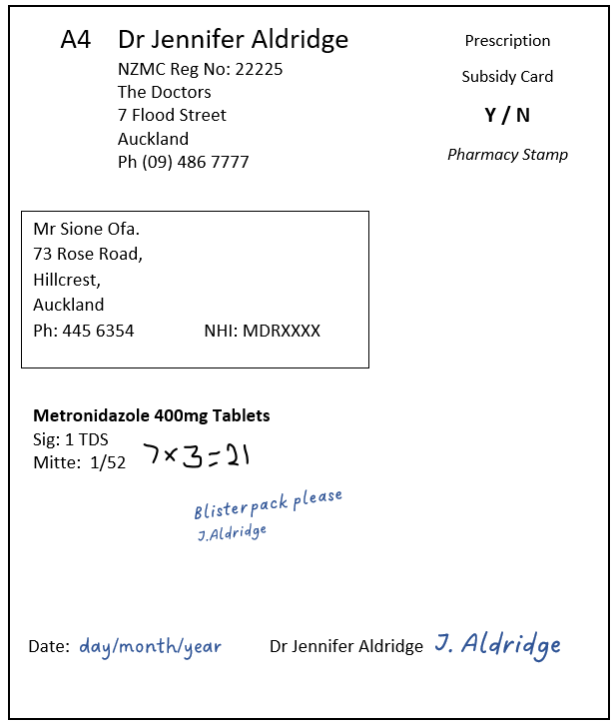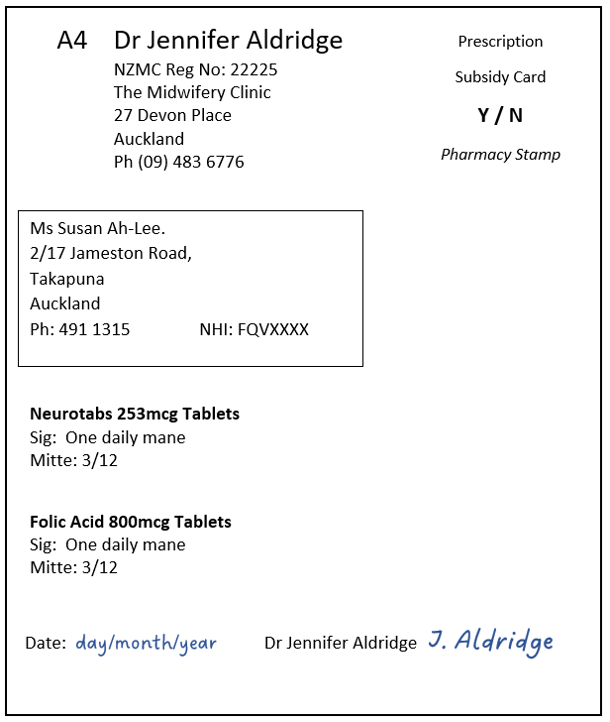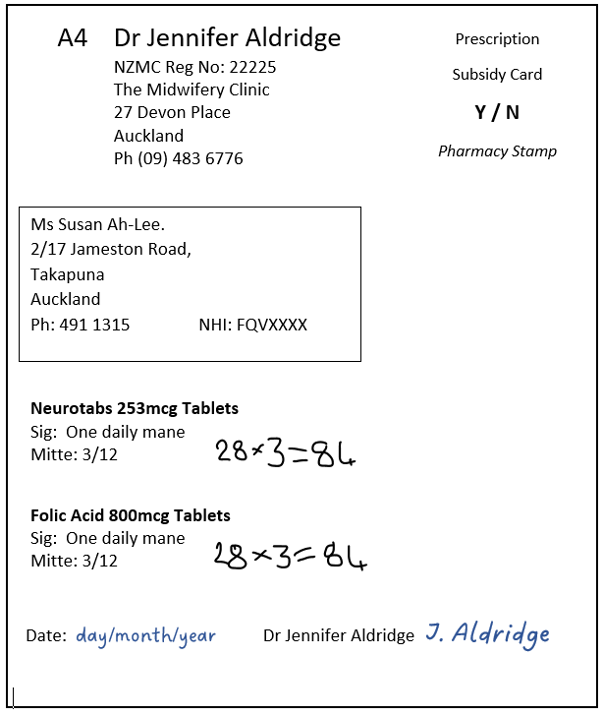Fakaalofa atu, welcome back
This week you will flex your communication skills as we explore the importance of effective communication with patients, continue supporting patients with compliance packaging, and cover another health condition – osteoporosis.
Communication Techniques
Our focus in this session is on communication techniques used when informing patients on health-related matters. This includes techniques used to ensure that patients understand the health information provided. A large part of your role as a pharmacy technician is patient counselling, answering questions, and providing information in a way that the patient can understand. Therefore, communicating effectively is an important component of your professional responsibilities.
Creating your own resources
To assist your learning this week, you will be completing a number of scenario activities using the Document Tool.
Although you will be familiar with this now, we encourage you to:
- invest the time and energy into answering each question. Use these activities to practice (and show off!) applying your skills and knowledge in a safe space. These activities are designed to capture your reflection, revision, and research.
- download each activity. Save it with an identifiable title (such as ‘Professional Practice – Reflecting on Communication’) and in a folder on your device (it might be labelled something like: Document Tool Activities).
- use these activities as an opportunity to build up your personalised kete (basket) of learning resources and materials. You can continue to add notes to each activity as you learn more!
- connect with your tutor, classmates, and/or work placement colleagues to discuss the activities with them. They may have different perspectives, experiences, and knowledge to share, which will enhance your own learning.
Ka pai, let’s get started then!
The meaning of communication
You may remember exploring communication concepts, techniques and skills in your level 3 programme. Before we get into the content today, read this article (The Basic Elements of the Communication Process) for a refresher, and then work through the first activity to activate your prior knowledge of the meaning of communication.
Journal post
Reflecting on communication
You are already an expert in communication. You do it in many forms every day, with friends, family, strangers and communicating professionally in the pharmacy setting.
In this activity, you will reflect on your knowledge and experience, specifically in the workplace.
- Create a journal entry with the title: ‘Reflecting on Communication’.
- Answer these questions:
- What expectations do you think patients have about their communication and interaction with pharmacy technicians?
- What do you think is meant by the term "effective communication”?
- Is effectively communicating a crucial skill for a pharmacy technician to have when interacting with patients and their whānau? Explain why or why not.
- Create a list of communication techniques that are important for pharmacy technicians to use.
- Save the journal permalink to your Index of Journal Posts.
- Once you’ve completed your online Professional Practice study this week, go back to this journal post and add any other techniques that you think are important. Learning is a journey, so by revisiting what you know, you can celebrate what you’ve since learned!
Communication Techniques
Communication techniques are the methods we use to communicate with patients, ensuring they receive vital health-related information in a clear, compassionate, and understandable manner.
The specific communication techniques we will be looking into are:
- Active listening
- Summarising and paraphrasing
- Clarifying information from others
- Asking and answering questions
- Responding respectfully and in a non-judgmental manner
- Responding in a culturally appropriate manner
- Using appropriate verbal and non-verbal language
- Communicating information clearly and accurately
- Checking for customer understanding.
Did you get all of these on your list in your journal activity? Did you have some that aren’t listed? There are many different methods, approaches and styles of communication that people use, but don’t feel overwhelmed - you’ll be surprised by what you already know and do naturally.
Active listening
Let’s start by focusing on active listening. As you know, communication involves not only talking but also listening. For listening to be effective, it needs to be active. Reflect on your understanding of this communication technique in the following activity.
Forum activity
Empathic listening
Now, let’s extend the concept of active listening to include empathic listening. In this forum activity, you will learn more about what empathy and empathic listening are and how to use them to provide a high standard of care for your patients.
- Read the following two articles. Although the articles are aimed at pharmacists, they provide valuable information about the importance and positive outcomes of empathic communication with pharmacy patients. As you read, you might find it beneficial to jot down essential keywords and communication examples. You can then add this information to your existing notes.
- Article 1: The business of empathy: How pharmacists can improve performance by improving the human connection. This article explores the links between empathic care and communication and increased patient satisfaction, medicine adherence, patient health and pharmacy business benefits.
- Article 2: How to demonstrate empathy and compassion in a pharmacy setting. This article discusses the concepts of empathy, sympathy and compassion. It notes that empathy is a core element of providing patient-centred care and building therapeutic relationships with patients.
- What have you learned? In the class forum – Week 20 – Professional Practice: Empathic Listening, share one key point, tip or a new idea you will apply to your empathic listening technique.
- Remember to check out the forum to see the thoughts of your classmates as well.
Active and empathic listening are key communication techniques that hold great importance for pharmacy technicians when interacting with patients and providing information on health-related matters. These communication techniques allow you to understand the needs of your patients.
By actively listening, you can:
- be fully present and process the information shared by the patient.
- gather important information that ensures you deliver safe, appropriate, effective care and advice.
- avoid misunderstandings and inappropriate care and advice for the situation.
- build a trusting relationship between the pharmacy and the patient as the patient feels heard and understood.
- build trust and loyalty between the pharmacy, patient and the community, as the pharmacy is seen as providing excellent care and service.
- demonstrate ethical conduct by putting the health and well-being of patients first.
Summarising and Paraphrasing
Summarising and paraphrasing are communication techniques that are particularly valuable when communicating with patients. Draw on your own experience to answer the following questions – you may want to do some research (Google, refer to notes, talk to peers, etc.) for help if needed.
Why are these techniques important?
Imagine that you’re helping a patient with a general health-related matter. How would summarising and paraphrasing assist this situation?
Take a moment to think about the benefits of these communication skills.
Click the (+) symbol to compare your thoughts with our list:
- restate and condense information in a clear and concise manner.
- confirm you have correctly understood what your patient has told you, reducing the risk of misunderstandings.
- confirm you have not missed any key points and give the patient an opportunity to add more information as needed.
- reassure the patient that their words are valued, which shows respect, which is at the core of professional and ethical conduct.
- increase the patient’s satisfaction and positive experience in the pharmacy.
Clarifying
Imagine a scenario where a patient’s health is at risk because of a misunderstanding in medication instructions. Why would clarifying be a skill that you need? Take the opportunity now to reflect on what you already know about this communication technique and how it applies in a pharmacy setting.
Clarifying information involves seeking further details or information to ensure a complete understanding of what the patient is communicating. In your work as a pharmacy technician, this is an essential part of ensuring patient safety.
Take a moment to think about the benefits of clarifying.
Click the (+) symbol to compare your thoughts with our list:
- check that you have correctly understood the patient's information, reducing the risk of errors in medication dispensing or advice.
- resolve any ambiguous or vague information provided by the patient, promoting accurate communication.
- ensure that the information you provide is tailored to the patient's unique situation and needs.
- demonstrate your commitment to the patient’s well-being by taking time to seek clarification, which in turn helps to build trust.
- pinpoint the patient’s issues or challenges so you can provide the appropriate assistance.
Were there any benefits that you hadn’t thought about? If so, think of a time when you have demonstrated that skill in your practice. You might be surprised to find that it’s something that you do naturally. If not, write it down in your notes and think about how you will apply this in your work placement.
Asking and answering questions
Most conversations that you have involve asking and answering questions. These communication techniques are crucial elements of effective communication (especially in clarifying information). Now, let’s answer a few questions yourself!
Imagine you are working as a pharmacy technician at a busy retail pharmacy. A patient approaches the counter with a prescription for a medication they've never taken before and that they want to know more about.
As you have already learnt in this programme, it’s important to ask a patient the right questions to gather the necessary health information and to determine the appropriate pharmacy care and guidance to offer. You would need to ask and answer questions here to ensure that key information is clarified. You would also need to determine whether the question is within your scope of practice or if it requires you to refer them to the pharmacist.
By effectively asking and answering questions, you can:
- determine the patient's specific needs and tailor your advice to their individual needs.
- act in a respectful and empathic manner to help establish rapport and make the patient feel heard and understood.
- encourage patients to elaborate on their concerns so they can provide comprehensive information.
- provide accurate, clear, and relevant responses to the patient's enquiries or concerns about their health and medical needs.
- offer informative and accurate answers that empower the patient with knowledge about their health and medications.
Asking questions
Here are some points to remember when asking a patient questions:
- Communicate in clear and straightforward language, avoiding medical jargon. If jargon words are needed, make sure to check the patient has an accurate understanding of the word.
- Be aware of language, cultural and individual preferences in communication and adapt accordingly.
- Use open-ended questions to gather more detailed information, such as the description of symptoms.
- Use closed-ended questions when you need to obtain facts such as dose and medicine names.
- Ask one question at a time so the patient can focus on answering the question fully without confusion.
- Use an open, friendly tone and allow the patient time to think before responding.
- If they seem confused by a question, rephrase the question in another way.
- Be open, accepting, and non-judgmental of the answers given.
- Explain why you are asking a question. For example, “Can you tell me what medications or supplements you are currently taking? This will help me to recommend a product that will be safe for you to use.”
- Ask follow-up questions if you need more information. For example, “Can you tell me more about what this pain feels like?”
- Pay attention and focus on the patient’s answers, giving signals that you are listening, such as head nodding or words such as “OK, I see” or “Yes”.
Answering questions
Here are some points to remember when answering a patient’s questions:
- As with asking a question, communicate with clear and straightforward language.
- Be aware of language, cultural and individual preferences in communication and adapt accordingly.
- Direct your attention to the patient when answering and observe their response to gauge if you have answered their question or if more explanation or clarification is needed.
- Answer the question that was asked and ask if they require any further information or clarification.
- If appropriate and available, provide written information to answer questions to accompany verbal answers.
- If you need to use a resource to answer a patient’s question, say so and return promptly with the answer.
- If you need to refer the patient’s question, explain why.
Self-directed learning activities
Week 20 Communication
For your activities this week, you will summarise some of the communication concepts we have covered.
Activity 1
Watch: How miscommunication happens (and how to avoid it) (4:32 minutes)
As you watch this video, make your own notes on any new information that we haven’t covered in this topic or that you didn’t already know. You can add these notes to your other notes on communication.
Activity 2
- Create a new journal post* titled 'SDL – Week 20 Communication.’
- Describe a situation from work placement where you felt your communication with a patient was effective. Briefly explain:
- The situation: For example, "A patient came into the pharmacy to fill a new prescription."
- Your role in the situation: For example, "The patient asked me…" / "It was my job to explain…"
- The actions you took: For example, "I took the patient to a quieter area of the shop and…"
- The result of your actions: For example, "The patient said they understood.." / "The patient thanked me for…"
*Note:
The SDL activities for Weeks 20, 21 and 22 will serve as prep for your upcoming assessment. Make sure to title your journal entries (using the title above – for example, ‘SDL – Week 20 Communication’) and save the permalink to your Index of Journal Posts. This will help you to track down the relevant information when you need it.
In our next session, we will continue to explore other communication techniques. In the meantime, continue to reflect on what you’ve learned in this session and practice applying these techniques in your mahi (work). We also encourage you to go back to your 'Reflecting on Communication' journal post that you created at the beginning of this topic and add any new reflections. This will allow you to expand your understanding of the topic.
You have now completed week 20 of Professional Practice, ka pai hoki koe, good on you!

Welcome back to our exploration of compliance packaging. This week, we’ll continue to look at how compliance packaging supports patients’ adherence to their medicine treatments. Me tīmata tātou – let’s get started.
Ways to configure compliance packs
You will be familiar with the blister packaging of a Medico Pak. You have previously explored the Medico Pak website, so let’s review what we know about how this type of packing is configured.
The blisters and rows on a Medico Pak are perforated to allow the patient to tear off a full day of medication or one dosing blister at a time. This makes it convenient for taking medication when away from home for a period of time. The patient can take with them only the amount needed rather than the whole pack, which can be difficult to transport.
Blister pack features
Can you recall the other features of each side of the pack? Test yourself and quickly jot down as many as you can remember on a scrap of paper. Once you’ve done that, click on each (+) symbol to compare your answers with ours.
Examples of packaging
Let’s look at some examples of packaging by starting with a scenario.
Scenario
Sione Ofa
Sione Ofa has a painful leg ulcer. He has been seen by his doctor, who has given him this prescription.

Read Sione’s prescription carefully and answer the following five questions:
How would you annotate this prescription with the quantity of each medicine to be dispensed each week, including calculations? Work it out yourself before clicking the (+) icon to see the sample answer.

As Sione will be taking his medication three times a day for seven days, you configure his pack as a weekly pack.
You check the New Zealand Formulary (NZF) and see that these tablets should be taken with food. Therefore, you decide that the best way to label the times of the day is with the names of the three meals. This will help Sione remember to take each dose with food.
As Sione will start taking his tablets on a Friday, the days of the week labels will start with Friday on the bottom row. Sione will take his tablets starting with breakfast on Friday morning. This means that he will take his medicine from the left-hand blister on the bottom row. At lunchtime, he will take medicine in the second blister from the bottom row and the third blister at dinnertime. Each row of his pack is one day’s worth of tablets.
You have now prepared Sione’s Medico Pak. Sione has arrived to collect his medication. Before handing the pack to him, take one last look to check that you have picked up the correct pack for the correct person, the pack is prepared correctly and is securely sealed.
You are about to put Sione’s Medico Pak in a carry bag, but you stop to ask him if he has ever had a Medico Pak before.
He replies:
“No, this is the first time. The last time I had pills to take, I kept forgetting them. I told the doc that, and she said she would get you guys to put them in a bubble pack. I just pop the pill out the back of that thing aye?”
Journal post
Medico Pak: Patient Counselling
- Create a new journal post titled, ‘Medico Pak: Patient Counselling’.
- In your journal, explain to Sione how to take his medication.
- Save the permalink to your Index of Journal Posts document.
Ka pai, Sione now has his medication and is confident in understanding how he needs to take it. Now, there is another patient who needs your assistance.
Scenario
Susan Ah-Lee
Susan is in the first few weeks of pregnancy. Her doctor has prescribed her the following medications.

Step into the role of a pharmacy technician to support Susan. Read Susan's prescription and answer the following questions.
How would you annotate this prescription with the quantity of each medicine to be dispensed each week, including calculations? Work it out yourself before clicking to see the sample answer.

Susan’s prescription is for once-daily dosing for a period of 3 months; therefore, you configure her pack as a monthly pack.
Her tablets are both to be taken in the morning. She has no other medicine to take on a regular basis. Therefore, you will label each column with ‘morning’. As Susan will start taking her tablets on a Friday, the days of the week labels will start with Friday on the bottom row.
Susan will take her tablets starting with ‘morning' on Friday morning. This means she will take the left-hand blister on the bottom row. Then, on Saturday morning, she will take her tablets from the blister directly above. Each column of this pack is one week’s worth of tablets.

Answer the following three questions to get Susan’s prescription ready for collection.
Good work! Susan's prescription is now ready for collection. You now know how to configure weekly and monthly blister packs, as well as provide clear instructions for patients on how to take their medication. Remember, if you’re uncertain about your answers, don’t be shy to discuss the scenario with your support network – your tutor, classmates, and work placement colleagues.
Self-directed learning activities
Week 20 Compliance Packaging
Reflect on your experiences so far with compliance packaging in your workplace and answer the following questions in your journal under the title ‘SDL – Week 20 Compliance Packaging’. You may need to talk to the pharmacy staff to get the information you need.
- Does your pharmacy have patients who have their medicines dispensed in a Medico Pak?
- If so, approximately how many Medico Paks would be dispensed in a month?
- Do they dispense packs for patients in rest homes or private hospitals?
- Have you been involved in dispensing Medico Paks? If so, describe what activities you were involved in or what you have observed.
- Does your pharmacy dispense medicines in sachets or any other type of compliance packaging? If so, describe them.
- Does your pharmacy have specific Standard Operating Procedures (SOPs) for compliance packaging, and have you looked at them? If you haven’t looked at them, make sure to locate and read them.
- What verbal or written advice does your pharmacy provide for their patients to help them adhere to their medicine regime, such as tips and guides for remembering when to take a dose?
- Save the permalink to your Index of Journal Posts.
Congratulations, that’s another week of Introduction to Dispensing complete.

Nǐ hǎo, hello and welcome back to Patient Care. In this session, we continue with our journey through different health conditions and pharmacy treatments.
Osteoporosis
This session is a little different. You will use your research skills to explore the health condition osteoporosis and the medicines and pharmacy treatments used in the treatment and management of this condition. By carrying out your own search for reliable and current information, you not only build your knowledge but also strengthen your information searching and critical reading skills. Research is a great way to learn!
Journal post
Osteoporosis research
The following are enquiry questions to guide your research.
Record your findings in your journal under the title: ‘Osteoporosis Research’. Remember to save the permalink to your Index of Journal Posts.
Enquiry Questions:
- What is osteoporosis?
- Explain what this health condition is, its signs, symptoms, and causes.
- What populations are affected by the condition?
- What are the risk factors associated with osteoporosis?
- How is osteoporosis diagnosed?
- Describe the tests used and what is meant by bone density.
- What are the common medications for osteoporosis?
- Identify the class of medications used in the treatment of osteoporosis. (Hint: start your research by searching the word osteoporosis in the NZF.)
- How do these medications work to strengthen bones?
- Choose one of these medications to investigate further and note:
- The medicine’s name
- The dose form and route of administration
- Directions for administration
- Potential side effects and any patient advice.
- Lifestyle and dietary interventions:
- Explore non-pharmacological approaches to managing osteoporosis, such as diet and exercise.
- Are there any OTC supplements or vitamins that can complement osteoporosis treatment?
- What foods should a person with this condition include in their diet and why?
- Explore non-pharmacological approaches to managing osteoporosis, such as diet and exercise.
How did you go with this activity? Was there anything you had difficulty answering? If so, read on and conduct some extra research or reach out to a classmate or your tutor for their support.
The following are the guidelines for when to refer to a pharmacist. These points can be found in the Healthcare Handbook, but you may want to add this information to your research notes as well.
⚠ When to refer to a pharmacist:
- People with other health conditions, pregnant or breastfeeding, or who have allergies to medications
- People taking medicines such as benzodiazepines, blood pressure lowing medicines or other medicines that might cause dizziness and increased risk of falls
- People without osteoporosis who are taking calcium supplements (unless recommended by a doctor)
- People having frequent falls
- People with a history of fractures
- People under 40 or over 80.
Self-directed learning activity
Watch: Osteoporosis (5:30 minutes)
This video summarises the learning from this session. It covers the causes, prevention and treatment of osteoporosis and includes some great animations that illustrate a basic overview of bone tissue anatomy.
As you watch, reflect on what you already know. Add to your notes with any information that is new to you.
And just like that, you’ve wrapped up another week of online study. Give yourself a pat on the back for a job well done. Tekeraoi n am tokanikai, congratulations!
